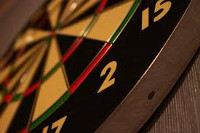A Guide to Darting Terms
 Darts has a language all of its own and though the terminology used isn’t always confusing, it helps to have a grasp of the language. Compared to a sport such as horse racing, the slang isn’t quite so obscure but there are terms that are unique to the game.
Darts has a language all of its own and though the terminology used isn’t always confusing, it helps to have a grasp of the language. Compared to a sport such as horse racing, the slang isn’t quite so obscure but there are terms that are unique to the game.
In this guide we will give you a rundown of the most common of these idiosyncratic phrases with the aim of enhancing your enjoyment of what is a great sport.
Oche
Darts commentators frequently talk of a player stepping up to the ‘oche’. This is simply the line that the player must stand behind when throwing the darts. The throwing player must stand so that no part of their foot must extend beyond the line and in some cases, the oche is raised in order to ensure this.
In any standard darts match, that line is draw at seven feet, nine and a quarter inches from the dartboard. No one is entirely sure as to where the name originated from although it’s widely thought that it was originally referred to as a ‘hockey’, possibly after a manufacturing firm involved in the early form of the game. Over the years, the abbreviated version is recognised across the darting world.
Bullseye
In darts, players are often looking to hit the bullseye or the ‘bull’. This is the small red circle in the very centre of the board and it’s worth 50 points when hit. As such, this isn’t the highest scoring portion of the dartboard but the bullseye does play a very important role.
Players can use the bull to complete an out shot just as they would with any double on the board. It can also be used to determine which player throws first in a set as both line up with a single throw and ‘nearest the bull’ wins it.
Arrows
The term ‘arrows’ merely refers to a player’s set of darts. The comparison is almost certainly due to the games originating from a time where darts were used as a form of combat.
Average
Averages are used in most sports and darts is no exception. When an average is shown, that’s the combined score for every three darts thrown and the magic number for players to achieve here is 100.
Bed and Breakfast
This is another term which goes by many names. Breakfast, Dreaded, Egg and Chips and Bagadix are also used but Bed and Breakfast is the most common form of slang. They all relate to a score of 26 which a player lands by hitting a twenty, a five and a one in a three-dart throw.
Bed
In contrast to the above term, a bed simply refers to a certain section of the board. It’s usually applied to a double or treble but this is what commentators mean when they refer to a player ‘hitting the bed’.
Big Fish
A big fish relates to the 170 highest checkout. It’s also referred to as the simple ‘maximum checkout’ and it refers to a throw of two treble 20s followed by the bullseye.
Bounce Out
A bounce out occurs when a dart hits the board and comes back out again. This usually happens when the dart hits a wire.
Bust
In darts, you will occasionally hear of a player busting. This means that they have scored more points than they actually need to win a leg. For example, a thrower may need double one to checkout but they slide into the single twenty by mistake meaning that they have ‘bust’ and will have to wait their turn to throw again.
Checkout
We’ve touched on the term ‘checkout’ throughout this review. This refers to the exact score needed by a player to win a leg.
Double Top
This term is used in reference to the double 20 sector of the board. It’s named in this way because the section is at the very top of the dartboard.
Downstairs
On commentary, it’s often said that a player is heading ‘downstairs’. This refers to the lower section of the board and in most cases, the thrower is aiming at treble 19.
Flights
The flights are the very wings of the dart that attach to the metal ‘javelin’. They are affixed and are responsible for the aerodynamics of the dart itself.
Game On
The phrase ‘game on’ is announced by the caller to let everyone know that a match has started.
Game Shot
Following on, the term ‘game shot’ is announced when a player hits the winning double, or the bullseye, to close out the match.
Lipstick
This particular term has crept into darts slang only recently. The lipstick is the treble twenty portion of the board and is the highest scoring section. Players look to ‘hit the lipstick’ and the bright red colour is presumably where the comparison comes from.
Maximum
The highest possible score with three throws of the darts is 180. This consists of three treble 20s and is commonly referred to as a ‘maximum’.
Mad House
There are a number of terms that refer to the double one sector of the board. Annie’s Attic and Annie’s Room are also used but in the modern day, when players need the double one to close out a game, they are often referred to as being in the ‘mad house’.
Nine Darter
Professional darts requires players to reach a score of 501 and the minimum throws needed to achieve this is nine. This remains a fairly rare event in darts and there is usually a separate prize for any player who achieves it.
The feat is known as a nine darter and there are a number of ways in which a thrower can get to this mark. The most common, however, involves a run of seven treble 20s, followed by a treble 19 and a double twelve. Occasionally this is also referred to as a perfect game.
Shanghai
The term ‘Shanghai’ is very commonly used in darts. It usually applies to the 20 section of the board and involves hitting a treble, a double and a single of the same number with three darts.
Single Bull
Also referred to as the outer bull, this applies to the circular green section of the board that surrounds the bullseye. If hit, a player scores 25.
Three in a Bed
The term ‘three in a bed’ relates to the act of hitting the same number with three darts. It most commonly occurs when a player hits three single 20s but it can apply to any area of the board.
Toe Line or Throw Line
These two terms are both alternatives to the word ‘oche’. Outside of the professional arena, most amateur players throw darts on a mat. A line is drawn from the throwing point and this is how these alternative phrases originate.
Ton
As it is with other sports, a ton refers to a score of 100 or more. The words ‘ton’ or ‘ton plus’ are frequently used by darts commentators.
Upstairs
We’ve covered the term ‘downstairs’ so, as you will have guessed, the word ‘upstairs’ refers to the top half of the board.
Other darting terms may appear at times but they are rare and very obscure. These are the most common forms of slang that you will hear in a match. They’re simply intended to make darts more accessible, leaving you free to sit back and enjoy this great sport.
